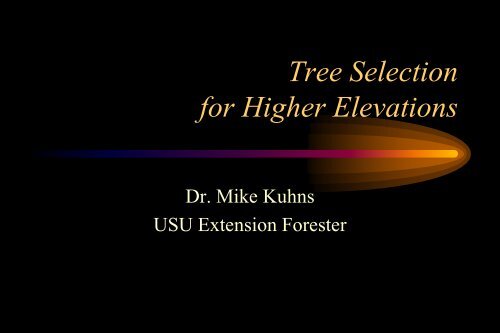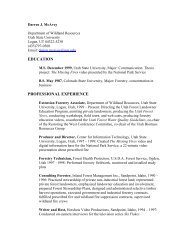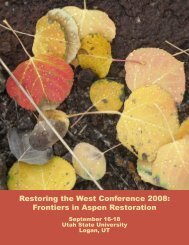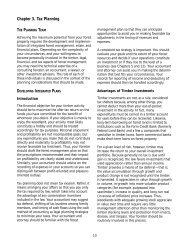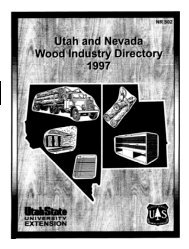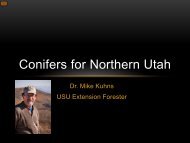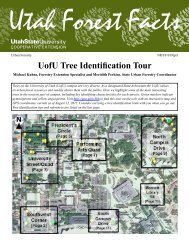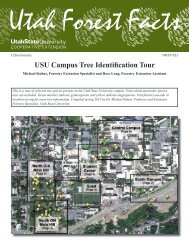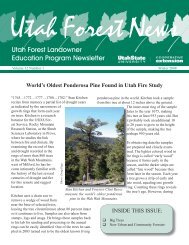Tree Selection for Higher Elevations - Forestry - Utah State University
Tree Selection for Higher Elevations - Forestry - Utah State University
Tree Selection for Higher Elevations - Forestry - Utah State University
- No tags were found...
You also want an ePaper? Increase the reach of your titles
YUMPU automatically turns print PDFs into web optimized ePapers that Google loves.
<strong>Tree</strong> <strong>Selection</strong><strong>for</strong> <strong>Higher</strong> <strong>Elevations</strong>Dr. Mike KuhnsUSU Extension Forester
Why is elevation an issue in <strong>Utah</strong>?1,700’3,400’MeanElevation3,300’2,900’5,500’5,000’6,100’3rd4,100’6,700’2nd6,800’1st5,700’
Why is elevation an issue in <strong>Utah</strong>?• Summit County 2 nd highest (8,388’) in U.S.outside Colorado• Wasatch County 5 th highest (7,919’)• Piute County 7 th highest (7,739’)• Duchesne County 8 th highest (7,714’)• Sevier County 13 th highest (7,517’)
Elevation• Non-green areas areabove about 6,000 feet
How much of an issue is growing landscapetrees at high elevations in <strong>Utah</strong>?• Proportional to how many people live at, andgrow cultivated landscapes at high elevations• Now fairly few people at high elevations• More will be in the future; Summit County one offastest growing in the state; Wasatch also growing• Edges of cities moving up onto benches
Populationdensity5,000-28,000500-5,00080-50030-805-301-5
How high elevationaffects trees• Most native <strong>for</strong>estin <strong>Utah</strong> is at highelevation (aboveabout 6,000’), so itmust be good <strong>for</strong>trees overall
<strong>Higher</strong> elevation means (almost always):• Lower low temperatures (winter) (- tree effect)• Lower high temperatures (summer) (+ -)• Shorter growing season (later, earlier frosts) (-)• Snow lasts longer, soils dry out slower (- +)• Increased precipitation (summer and total) (+)• Decreased ET (lower summer temp, higher humidity) (+)• Increased climate fluctuations (~)
Temperature• 5F decrease per 1,000’ (adiabatic cooling)– From SLC at 4,200’ to Park City at 9,000’ can get a 24Ftemperature drop• 1F decrease per degree latitude north– From Bluff at about 37 latitude to Logan at about 42 latitudecan get a 5F temperature drop (same elevation)• So, <strong>Utah</strong> gets cooler as you go up in elevation and as yougo farther north
Coolertemperatures59FMean Annual Temperature(source www.nr.usu.edu/Geography-Department/utgeog/climate.html)
Cooler minimumtemperatures-43.6F-40.0F-36.4F-32.8F-29.2F-25.6F-22.0F-18.4F-14.8F-11.2F-7.6F-4.0F-0.4F+3.2F+6.8F+10.4F+14.0F+17.6F30 Year Mean Minimum Temp(source www.nr.usu.edu/Geography-Department/utgeog/climate.html)
Shorter growingseason (frost-free)0-20 Days20-4040-6060-8080-100100-120120-140140-160160-180180-200200-220Average frost free season (days)(source www.engineering.usu.edu/uwrl/atlas/ch2/ch2freezetemp.html)
Snow lastslongerAverage snowfall (inches)(source www.engineering.usu.edu/uwrl/atlas/ch2/ch2avannsnow.html)
IncreasedprecipitationMean Annual Precip1961-1990
DecreasedETAverage PET (inches)(source www.engineering.usu.edu/uwrl/atlas/ch3/ch3potevapot.html)
<strong>Higher</strong> elevation in <strong>Utah</strong> often means:• Increased relief, so greater effect of aspect (~)• Less uni<strong>for</strong>mity across the landscape (climatic,soils, vegetation, etc.) (~)• Decreased (more acidic) soil pH (below 7) (+)• Rockier, thinner soils (highly variable) (-)
Relief/aspect
Relief/aspect
Poorer soils(arability)(source www.engineering.usu.edu/uwrl/atlas/ch3/ch3arable.html)
So, what is a “higher elevation”?• High enough that factors affect trees• High enough <strong>for</strong> some detrimental effects• <strong>Tree</strong>s naturally grow above about 15” precip• <strong>Tree</strong>s grow naturally above about 6,000’ and belowabout 11,000’ in <strong>Utah</strong>• Could use 7,000’ as a cutoff, but really anywhere whereelevation has an effect
So, what is a“higher elevation”?• Everything not shownin green
Site and tree assessment is crucial• Increased importance of microsite– Elevation, slope steepness, aspect, soils, rockiness,frost free period, moisture, temperature (summer &winter), windiness• Look at USDA Hardiness zone of site and tree– Look in <strong>Tree</strong>s of <strong>Utah</strong> book <strong>for</strong> table• There are natives (unlike at low elevations), souse natives where possible
USDA Hardiness ZonesSummit & Wasatch CountiesStation Elevation (feet) Zone (Ave., Min.)Summit Coalville 5550 5, 3Summit Echo 5470 4, 3Summit Kamas 3 NW 6480 5, 3Summit Wanship 5940 4, 3Wasatch Deer Creek 5270 5, 3Wasatch Heber 5630 5, 3Wasatch Snake Creek 6010 5, 3
4b3b4aHardiness zones6b6a7a5a5b7a• USDA PlantHardiness Zones• Meant <strong>for</strong> coldhardinessindication, not heat8a7b
Calculatedhardiness zones-43.6F (2b)-40.0F (2b)-36.4F (3a)-32.8F (3b)-29.2F (4a)-25.6F (4a)-22.0F (4b)-18.4F (5a)-14.8F (5b)-11.2F (5b)-7.6F (6a)-4.0F (6b)-0.4F (6b)+3.2F (7a)+6.8F (7b)+10.4F (8a)+14.0F (8a)+17.6F (8b)30 year average minimum temp(degrees F) (zone)(source www.nr.usu.edu/Geography-Department/utgeog/climate.html)
Selecting better trees (<strong>for</strong> any elevation)• Moderate to slow growth rate; no fast growers• Longevity• Native where appropriate; well adapted to site ismost important• Better cultivars• Mix sizes• Interesting characteristics
<strong>Selection</strong> criteria• Tolerance of low temperatures in winter• Tolerance of frost on fringes of growing season– Occasional very late/early frosts are problems with almost anyspecies, even natives• USDA Zone 4b or lower (generally)• Quality tree (few I/D problems, medium/slow growth,strong, good <strong>for</strong>m)• USU <strong>Tree</strong> Browser shows 137 species Zone 4 or colderwith medium to slow growth rate; 26 natives
Some trees to avoid• Avoid– Any willow (Salix species)*– Almost any poplar/cottonwood (Populus species)*– Russian-olive (Elaeagnus angustifolia)– Norway maple (Acer platanoides)• Normally avoid, but may work on high, cool sites– European white birch (Betula pendula)– blue spruce in hot locations (Picea pungens)– quaking aspen (Populus tremuloides)*May be OK in native settings
<strong>Tree</strong>s <strong>for</strong> high elevations in <strong>Utah</strong> – Natives• Selected broadleaves (15 in UTB)– canyon maple (Acer grandidentatum)– water or river birch (Betula occidentalis)– curlleaf mountain-mahogany (Cercocarpus ledifolius)– quaking aspen (Populus tremuloides)– common chokecherry (Prunus virginiana)– Gambel oak (Quercus gambelii)– Greene mountain-ash (Sorbus scopulina)
<strong>Tree</strong>s <strong>for</strong> high elevations in <strong>Utah</strong> – Natives• Conifers (11 in UTB)– Douglas-fir (Pseudotsuga menziesii)– fir – white, subalpine (Abies concolor, lasiocarpa)– juniper – Rocky Mountain, <strong>Utah</strong> (Juniperusscopulorum, osteosperma)– pine – limber, lodgepole, ponderosa, pinyons (Pinusflexilis, contorta, ponderosa, edulis, monophylla)– spruce – blue, Engelmann (Picea pungens,engelmannii)
<strong>Tree</strong>s <strong>for</strong> high elevations in <strong>Utah</strong> – Zone 2• Amur maple (Acer ginnala)• birch – European white, paper (Betula pendula,papyrifera)• bur oak (Quercus macrocarpa)• American basswood/linden (Tilia americana)• pine – Scots, mugo (Pinus sylvestris, mugo)• spruce – Norway, white (Picea abies, glauca)• northern white-cedar (Thuja occidentalis)
<strong>Tree</strong>s <strong>for</strong> high elevations in <strong>Utah</strong> – Zone 3• maple – Norway, red, Tatarian (Acer platanoides, rubrum,tataricum)• horsechestnut, Ohio buckeye (Aesculus hippocastanum,glabra)• American hornbeam (Carpinus caroliniana)• eastern redbud (Cercis canadensis)• fringetree (Chionanthus virginicus)• pagoda dogwood (Cornus alternifolia)• hawthorn – cockspur and Washington (Crataegus crusgalli,phaenopyrum)
<strong>Tree</strong>s <strong>for</strong> high elevations in <strong>Utah</strong> – Zone 3• white ash (Fraxinus americana)• ginkgo (Ginkgo biloba)• Kentucky coffeetree (Gymnocladus dioicus)• magnolia – cucumbertree, Kobus, Loebner (Magnoliaacuminata, kobus, x loebneri)• Apple, crabapple (Malus pumila, etc.)• Amur corktree (Phellodendron amurense)• cherry – sweet, sour (Prunus avium, cerasus)• Amur chokecherry (Prunus maackii)• European birdcherry (Prunus padus)
<strong>Tree</strong>s <strong>for</strong> high elevations in <strong>Utah</strong> – Zone 3• Ussurian pear (Pyrus ussuriensis)• oaks – white, swamp white (Quercus alba, bicolor)• locust – black, Idaho flowering (Robinia pseudoacacia, xambigua)• mountain-ash – Korean, American, European (Sorbusalnifolia, americana, aucuparia)• Japanese tree lilac (Syringa reticulata)• linden – littleleaf, Crimean (Tilia cordata, x euchlora)• Chinese juniper (Juniperus chinensis)• Japanese red pine (Pinus densiflora)
<strong>Tree</strong>s <strong>for</strong> high elevations in <strong>Utah</strong> – Zone 4• maple – hedge, paperbark, sycamore, purpleblow (Acercampestre, griseum, pseudoplatanus, truncatum)• red horsechestnut – (Aesculus x carnea)• downy serviceberry – (Amelanchier arborea)• European hornbeam (Carpinus betulus)• Chinese chestnut (Castanea mollissima)• katsuratree – (Cercidiphyllum japonicum)• yellowwood – (Cladrastis kentuckea)• dogwood – Kousa, corneliancherry (Cornus kousa, mas)
<strong>Tree</strong>s <strong>for</strong> high elevations in <strong>Utah</strong> – Zone 4• filbert, hazelnut (Corylus species, esp. colurna)• smoketree (Cotinus spp.)• hawthorn – English, green, Lavalle (Crataegus laevigata,viridis, x lavallei)• European beech (Fagus sylvatica)• Osage-orange (Maclura pomifera)• Magnolia – lily, star, saucer (Magnolia liliflora, stellata, xsoulangiana)• apricot (Prunus armeniaca)• cherry – Sargent, Higan (Prunus sargentii, subhirtella)
<strong>Tree</strong>s <strong>for</strong> high elevations in <strong>Utah</strong> – Zone 4• oaks – shingle, chinkapin, English, northern red (Quercusimbricaria, muehlenbergii, robur, rubra)• Japanese pagodatree (Sophora japonica)• silver linden (Tilia tomentosa)• lacebark elm (Ulmus parvifolia)• baldcypress (Taxodium distichum)• pine – Austrian, J. white, lacebark (Pinus nigra, parviflora,bungeana)• Serbian spruce (Picea omorika)
<strong>Tree</strong>s <strong>for</strong> high elevations in <strong>Utah</strong> –Faster growing• hackberry (Celtis occidentalis)• honeylocust (Gleditisia triacanthos)• yellow-poplar (Liriodendron tulipifera)• London planetree (Platanus x acerifolia)• larch – European, Japanese (Larix decidua,kaempferi)
canyon maple (Acer grandidentatum; Zone 4)* (native)
paperbark maple (Acer griseum; Zone 4)
Tatarian maple (Acer tataricum; Zone 3)
European hornbeam (Carpinus betulus; Zone 4)
curlleaf mountain-mahogany (Cercocarpus ledifolius; Zone 3)*
fringetree (Chionanthus virginicus; Zone 3); picture is C. retusus; Zone 5)
Washington hawthorn (Crataegus phaenopyrum; Zone 3)
European beech (Fagus sylvatica; Zone 4)
ginkgo (Ginkgo biloba; Zone 3)
Kentucky coffeetree (Gymnocladus dioicus; Zone 3)
yellow-poplar (Liriodendron tulipifera; Zone 4)
Loebner magnolia (Magnolia x loebneri ‘Leonard Messel’; Zone 3)
star magnolia (Magnolia stellata; Zone 4)
Amur chokecherry (Prunus maackii; Zone 3)
white oak (Quercus alba; Zone 3)
ur oak (Quercus macrocarpa; Zone 2)
English oak (Quercus robur; Zone 4)
Greene mountain-ash (Sorbus scopulina; Zone 2)*
Japanese tree lilac (Syringa reticulata; Zone 3)
white fir (Abies concolor; Zone 2)*
white fir (Abies concolor) foliage*
Rocky Mountainjuniper (Juniperusscopulorum; Zone 3)*‘Gray Gleam’ cv.
European larch (Larix decidua; Zone 4)
Blackhills (white) spruce (Picea glauca ‘Densata’; Zone 2)
Serbian spruce (Picea omorika; Zone 4)
lacebark pine (Pinus bungeana; Zone 4)
Japanese red pine (Pinus densiflora; Zone 3)
limber pine (Pinus flexilis; Zone 4)*Vanderwolf’s Pyramid cv.
ponderosa pine (Pinus ponderosa; Zone 3)*
• Includes 241 trees• Select 21 characteristics• 1,000+ photos• Fact sheets• Select and save favorites• www.treebrowser.org<strong>Utah</strong> <strong>Tree</strong> Browser
References• Books– Dirr, Manual of Woody Landscape Plants– Kuhns, <strong>Tree</strong>s of <strong>Utah</strong> and the Intermountain West• Web sites– <strong>for</strong>estry.usu.edu– www.treebrowser.org– www.usna.usda.gov/Hardzone/ushzmap.html
Mike KuhnsDepartment of Wildland Resources<strong>Utah</strong> <strong>State</strong> <strong>University</strong>5230 Old Main HillLogan, UT 84322-5230mike.kuhns@usu.edu


